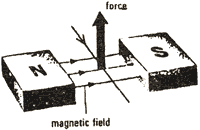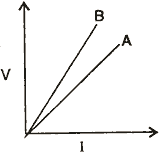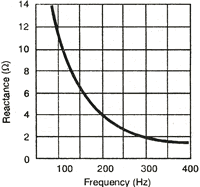CBSE Guess > Papers > Question Papers > Class XII > 2003 > Physics > Compartment Delhi Set -I
PHYSICS—2003 (Set I—Compartment Delhi)
Q. 1. State two properties of nuclear forces.
Q. 2. Name the physical quantity which has its unit JT -1 . Is it a scalar or a vector quantity?
Q. 3. As shown in the figure, a charged particle enters a uniform magnetic field and experiences an upward force as indicated. What is the charge sign on the particle?

Q. 4. Two plane sheets of charge densities ![]() are kept in air as shown in the figure. What are the electric field intensities at points A and B?
are kept in air as shown in the figure. What are the electric field intensities at points A and B?

Q. 5. Name an appropriate communication channel, needed to communicate a signal of hand width 100 kHz over a distance of 8 km.
Q. 6. State Gauss' theorem in electrostatics. Using this theorem, prove that no electric field intensity exists inside a hollow charged conducting sphere.
Q. 7. The voltage-current graphs for two resistors of the same material and same radii with lengths L1 and L2 are shown in the figure. If  state with reason, which of these graphs represents voltage-current change for L 1 .
state with reason, which of these graphs represents voltage-current change for L 1 .

Q. 8. A ray of light passes through an equilateral prism (refractive index 1.5) such that angle of incidence is equal to angle of emergence and the latter is equal to 3/4th of angle of prism. Calculate the angle of deviation.
Or
Explain why does a convex lens behave as a converging lens when immersed in water  and as a diverging lens, when immersed in carbon disulphide
and as a diverging lens, when immersed in carbon disulphide 
Q. 9. Draw the graph to show the variation of thermo-electric e.m.f. with the temperature of the hot junction. How does (i) neutral temperature and (ii) temperature of inversion of a thermocouple change, if the temperature of the cold junction decreases?
Q. 10. The potential difference across the collector of a transistor, used in common emitter mode is 1.5 V, with the collector resistance of  . Find (i) the emitter and (ii) the base current, if the d.c. gain of the transistor is 50.
. Find (i) the emitter and (ii) the base current, if the d.c. gain of the transistor is 50.
Q. 11. Identify the logic gates marked P and Q in te given logic circuit.

Write down the output at X for the inputs (i) A = 0, and (ii) A = 1, B = 1.
Q. 12. Establish the relation between drift velocity  of the electrons in a conductor of cross-section 'A', carrying current
of the electrons in a conductor of cross-section 'A', carrying current  and concentration of free electrons per unit volume of the conductor being
and concentration of free electrons per unit volume of the conductor being  .
.
Q. 13. Define the term 'potential gradient'. With the help of a circuit diagram, explain how a potentiometer can be used to compare the e.m.f.'s of two primary cells.
Q. 14. A hydrogen ion of mass 'm' and charge 'q' travels with a speed  along a circle of radius 'r' in a uniform magnetic field of flux density 'B' Obtain the expression for the magnetic force on the ion and determine its time period.
along a circle of radius 'r' in a uniform magnetic field of flux density 'B' Obtain the expression for the magnetic force on the ion and determine its time period.
Q. 15. State Lenz's law. Two identical loops, one of cooper and the other of aluminium are rotated with the same speed, in a uniform magnetic field acting normal to the plane of the loops. State with reason, for which of the coils (i) induced e.m.f., (ii) induced current, will be more
Q. 16. Which of the following can be polarised : (i) X-rays, (ii) sound waves? Give reasons.
Two Polaroids are used to study polarisation. One of them (the polariser) is kept fixed and the other (the analyser) in initially kept with its axis parallel to the polariser axis. The analyser is then rotated through angles of 450, 90 and 180 in turn. How would the intensity of light coming out of the analyser be affected for these angles of rotation, as compared to the initial intensity and why?
Q. 17. Two independent sources of light cannot be coherent. Why?
Two coherent sources have intensities in the ratio 25 : 16. Find the ratio of the intensities of maxima to minima, after interference of light occurs.
Q. 18. An electron and a proton have the same kinetic energy. Which of the two has greater wavelength? Justify your answer.
Are matter waves electromagnetic? What is the momentum of a photon of frequency  ?
?
Q. 19. A nucleus  undergoes
undergoes  to give the nucleus
to give the nucleus  Write down the
Write down the  equation. Calculate the kinetic energy of the electron emitted, assuming the mass of
equation. Calculate the kinetic energy of the electron emitted, assuming the mass of  as 22.994466 u and that of
as 22.994466 u and that of  as 22.989770 u. Rest mass of the electron may be ignored.
as 22.989770 u. Rest mass of the electron may be ignored.
Q. 20. How are materials classified according to their behaviour in a non-uniform magnetic field? Give one example of each.
Q. 21. What are inferior planets? Give its one example.
How can the distance of an inferior planet from the earth be determined using Copernicus method? Derive the expression.
Q. 22. Explain the formation of (i) 'potential harrier' and (ii) 'depletion region' in a p-n junction diode.
How does the width of the depletion region vary with increase in forward bias?
Or
What is the need of rectification? With the help of a circuit diagram, explain the working of a full wave rectifier. Draw its input and output waveforms.
Q. 23. What is a dipole antenna? What role does it play in the communication system? How does, the length of dipole antenna vary with the frequency of the carrier waves?
Q. 24. State two main advantages of optical communication method.
Assume that light of frequency  Hz is used in an optical communication system. If 2% of this frequency bandwidth is used, how many T.V. channels can be accommodated in this bandwidth? The bandwidth needed for T.V. transmission is
Hz is used in an optical communication system. If 2% of this frequency bandwidth is used, how many T.V. channels can be accommodated in this bandwidth? The bandwidth needed for T.V. transmission is  Hz/channel.
Hz/channel.
Q. 25. Draw a ray diagram to show the formation of the real image of a point object due to a convex spherical refracting surface, when the ray of light is travelling from a rarer medium of refractive index ![]() to a denser medium of refractive index
to a denser medium of refractive index 
Using this diagram, derive the relation between object distance (u), image distance (v), radius of curvature (R) of a convex spherical surface. State the sign convention and the assumptions made.
Or
Draw a ray diagram for the formation of image of a distant object by an astronomical telescope in normal adjustment position.
Deduce the expression for its magnifying power.
How does the resolving power of a telescope change if (i) the size of the aperture of the objective lens is increased, (ii) the focal length of the objective lens is decreased?
Q. 26. Figure given below shows how the reactance of a capacitor varies with frequency
(i) Use the information on graph to calculate the value of capacity of the capacitor.
(ii) An inductor of inductance 'L' has the same reactance as the capacitor at 10Hz. Find the value of L.
(iii) Using the same axes, draw a graph of reactance against frequency for the inductor given in part (ii).
(iv) If this capacitor and inductor were connected in series to a resistor of
 ., what would he the impedance of the combination at 300 Hz?
., what would he the impedance of the combination at 300 Hz?

Q. 27. Derive an expression for the energy stored in a parallel plate capacitor, with air as the medium between the plates.
A parallel plate capacitor of capacitance  is charged to 200 V. After disconnecting it from the battery, using an insulated handle, the distance between the plates is doubled. Find (i) potential difference between the plates, and (ii) energy stored in the capacitor, after the separation between the plates has been increased.
is charged to 200 V. After disconnecting it from the battery, using an insulated handle, the distance between the plates is doubled. Find (i) potential difference between the plates, and (ii) energy stored in the capacitor, after the separation between the plates has been increased.
- English
- Sociology
- Functional English
- Psychology
- Mathematics
- Philosopy
- Physics
- Computer Science
- Chemistry
- Entrepreneurship
- Biology
- Informatics Practices
- Geography
- Multimedia & Web Technology
- Economics
- Biotechnology
- Business Studies
- Physical Education
- Accountancy
- Fine Arts
- Political Science
- History
- Agriculture
